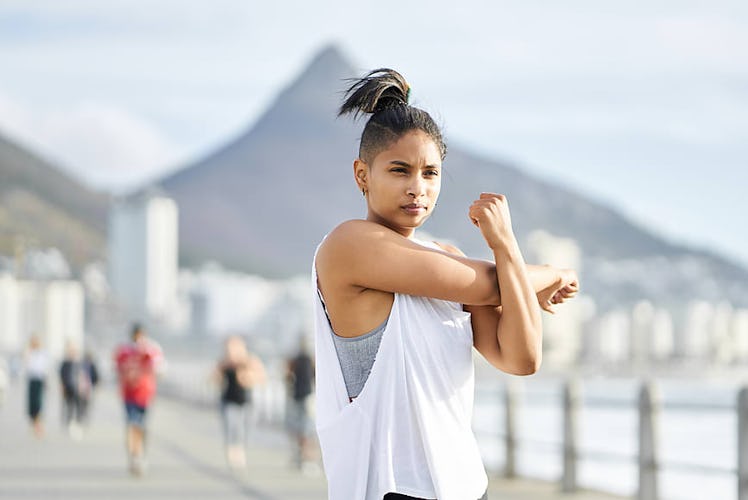
Here's Why Fitness Experts Say You Should Never Skip A Warm-Up Before Your Workout
If I'm being really honest, the only time I actually remember to stretch before a workout is when I'm doing yoga. Since the practice is so focused on being present in your body, I always take the extra time to warm up my muscles before settling into a flow. For other kinds of exercise, though, I have to wonder whether I'm doing my body a disservice by not giving myself a chance to ease into the workout. Do you have to warm up before working out? Experts say it really is worth taking a few extra minutes to prepare your body, even if, in the moment, it feels like it doesn't make much of a difference.
For one thing, an effective warm-up can help you prevent a nasty injury, says personal trainer and champion power lifter Robert Herbst. "A warm-up will improve the flexibility of joints and connective tissue, such as tendons, so it will prevent tears," he tells Elite Daily in an email. "Also, muscles contract more efficiently when their core temperature is raised, so there is less chance of a pull or tear," he explains, "and performance will be better and stronger."
Your heart also has a lot to gain from a warm-up, Herbst adds, because sudden cardio can shock your cardiovascular system. A gentle warm-up, on the other hand, can safely dilate your arteries and raise your heart rate to ensure your body can handle the exercise.
As for how long your warm-up should be, Herbst says there's no set length of time you should set aside to get your body ready for exercise. Factors like time of day, the temperature of your environment, your activity level, and any soreness you might already be feeling can all determine how long you'll need to warm up. "One should warm up for as long as it takes to get loose and ready," he tells Elite Daily. "One indicator [that you're warmed up] is if you are about to break a sweat."
One thing to note is that stretching and warming up are not interchangeable. "It's more logical to warm up first and then stretch," says personal trainer instructor and exercise physiologist Joe Cannon, MS, CSCS. For a good warm-up, spend some time doing low-intensity cardio like walking on a treadmill, using the rowing machine, riding a stationary bike, or using an elliptical machine, he suggests. "Also, studies show that stretching after working out is just as effective at improving flexibility as doing it before and after exercise," says Cannon, so you can definitely move your stretching to the end of your session if that works best for you.
According to online fitness coach Emma Green, PhD (c), MSc, BSc, it's best to address three main things in your overall warm-up. "The first of these is getting your heart rate up; something like jogging, jumping jacks, or skipping would work well here," she suggests. "The second stage is exercises relevant to what you're about to do: bodyweight exercises like lunges, squats, and push-ups, etc." Lastly, she tells Elite Daily, try to include a bit of dynamic stretching in your warm-up, which can include movements like leg and arm swings, torso twists, and walking lunges. Overall, says Green, really spend some time feeling out what your body specifically needs. "If [some] areas feel particularly tight or sore, you could spend longer on these areas, potentially including some foam rolling."
At the end of your workout, don't forget the warm-up's counterpart — the cool-down — so your body can gradually begin to relax again, says Armen Ghazarians, certified personal trainer and CEO of Finish Fit. "Static stretches [groin stretch, quad stretch, hamstring stretch, etc.] after a workout not only help with overall flexibility, but they also help reduce DOMS (delayed onset muscle soreness)," he tells Elite Daily in an email. Dedicate about 10 minutes after your session to cool down, he suggests, taking time to stretch all of your major muscle groups, and your body will surely thank you.